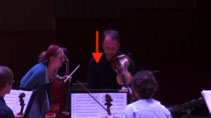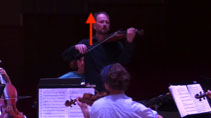The question of breathing
(V1cT2)
An intriguing issue concerning my study of gesture and body movement in general, and the sighing gesture in particular, is the question of the connection between musical structure and breathing (King, 2006). At the time of the rehearsals and concerts I was (unfortunately) not planning to explore breathing, and hence I did not set up any equipment to measure the frequency and locations of inhalations and expirations. Nevertheless, observation of the video material still gives an idea of the role of breathing.
As no quantifiable breathing data can be obtained, I established a model of approximate breathing sequences and compared it with the observed breathing events on the videos.
I base my model of breathing sequence on a spontaneous demonstration I made for my students at the first 'reading' rehearsal. I made an analogy to a real sigh and sobbing action. The length and depth of the expiration was to determine the shape of the sighing figure, while the 'sobbing' inhalation should gather the energy towards the next sigh.
Is there a coherence between playing the sighing gesture and the actual performance of a sigh?
In my observations, the gestural representation of a 'sigh' in bowing and body movement – and not the least in the sound – seemed to agree with my model of inhalation and expiration. The body moves in a slow expiratory-like shape until the bow/breath runs out, followed by sustained moment of inertia. As if out of necessity, I take a new breath/up-bow, resuming breathing, and preparing a new sigh/down-bow. However, on a closer look, I discovered some interesting discrepancies.
Even though there are frequent coordinated events between the bowing movements and the breathing sequence, I observed that the breathing does not seem to follow the entire shape of the bow gesture. The bow movement seems to take over the function of expressive breathing, and the actual breathing takes its own independent course until the next structural coordination is needed.
Another even more surprising incoherence occurred between the body movements supporting the bow action and the body movements accompanying the actual expiration. The playing movement of a sigh gesture goes upwards in one slow ascending trajectory towards the inertia 'on the top of the hill', while the shape of the sigh in the actual breathing demonstration 'collapses' downwards.


Ex. 1 A comparison between (1a) breathing vs. (1b) playing gesture trajectory.
Furthermore, in the playing version there is an accumulation of energy at the top of the inertial curve (Ex. 1b), but in the 'breathing' version (Ex. 1a), on the parallel spot of the sigh gesture, there seems to be no tension at the bottom of the downward motion.
To match a similarly loaded inertia momentum in the breathing version I would have to execute the sigh with upward movement as an inhalation, with the inertia on the top of the breath; letting the breath out in a downward motion would then coincide with the 'sobbing' motif.
This would align my playing and 'sighing' body movements, but breathing in would not do justice to a real sigh. The sigh executed on the expiration (especially with accompanying 'jaaaaj') feels more natural.
Should I then revise my body movement strategy in the playing version and move downwards on the sighing motif? This also feels unnatural, both in playing and even in singing (imagine the operatic exclamation 'Ah' in a high register performed with a downward collapsing movement…).
A sighing gesture is different to the throwing and sword fighting gestures. If it is not triggered by means of sub-textual signification, it most often comprises involuntary movements that are in real life seldom triggered by a calculative (or reflexive) intentionality. Clynes (1977) describes the physical act of sighing as ’initial downward exertion […] followed by a period of apparent weakness and relative immobility. […] Respiration tends to stop at the bottom of the expiratory phase, like the end of a sigh’ (Clynes, 1977, p. 3). Nevertheless, in a performance the violinist needs to execute the sighing gesture as if happening spontaneously. By mapping the embodied experiences of sighing, the holistic experience of performing the phrase on the instrument is altered. Furthermore, in the moment of performance, not only are the experiences of the involuntary sighing movements put into action, but so too is the experiential vocabulary of social interactions, where ‘sighing is eminently manipulable, suggesting that its occurrence in interaction can be conscious, purposeful, and used for social ends’ (Hoey, 2015, p 176). Again, we can see how a gesture-based understanding of musical performance allows for a more holistic perspective on musical perception and creation, displaying an ecology of embodied and socially constructed layers of signification.